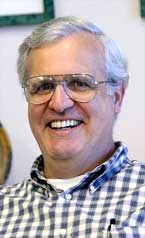
Handy Links
SLAC News Center
SLAC Today
- Subscribe
- Archives: Feb 2006-May 20, 2011
- Archives: May 23, 2011 and later
- Submit Feedback or Story Ideas
- About SLAC Today
SLAC News
Lab News
- Interactions
- Lightsources.org
- ILC NewsLine
- Int'l Science Grid This Week
- Fermilab Today
- Berkeley Lab News
- @brookhaven TODAY
- DOE Pulse
- CERN Courier
- DESY inForm
- US / LHC
SLAC Links
- Emergency
- Safety
- Policy Repository
- Site Entry Form

- Site Maps
- M & O Review
- Computing Status & Calendar
- SLAC Colloquium
- SLACspeak
- SLACspace
- SLAC Logo
- Café Menu
- Flea Market
- Web E-mail
- Marguerite Shuttle
- Discount Commuter Passes
-
Award Reporting Form
- SPIRES
- SciDoc
- Activity Groups
- Library
Stanford
Around the Bay
From the Acting Director of SSRL: Where do we go from here?

As with other scientific facilities, the Stanford Synchrotron Radiation Lightsource faces an ever-changing landscape of experimental requirements, as a result of changing national needs and discoveries that direct the focus of its extensive user communities into new directions. These new research directions give rise to opportunities as well as challenges to further develop SSRL's capabilities. These challenges are met by the technical staff throughout SLAC who push the accelerator and beamlines to new performance levels. As is often the case in science, these new technical capabilities will in turn push scientific users to come up with new experimental ideas.
Since its commissioning in 2004 as a third generation synchrotron facility, SSRL has been undergoing a process of continuous improvements, with reductions in emittance, increases in current as well as upgrades of all of its beamlines with higher performance monochromators, state-of-the-art detectors and new types of end stations too numerous to mention in a short article. In spite of all these advancements, the question that never goes away is: where do we go from here? To answer this question, we in SSRL management have been developing a strategic plan that looks forward at least five years to guide our thinking.
The guiding vision for SSRL's SPEAR3 accelerator is its continued development to both improve its capabilities and ensure the reliability we have grown to expect. The SPEAR3 core team has laid out an upgrade plan for the next five years, as well as the studies that will help us to define what will happen in the five years beyond that. At this point I should mention that we are reaching an exciting milestone for SPEAR3, which is the release of the trickle charge injection mode to user operations during the next month. As I have written in previous articles, in the trickle charge mode, the injection cycle goes from every 8 hours to every 10 minutes, resulting in a steady current in SPEAR3 and a constant power loading on the X-ray optics that helps to maintain stable photon beams. As we reach the 500 mA design current, an even more rapid injection cycle will become desirable. This will be addressed by upgrades we have identified as part of our strategic plan.
In our experimental programs we have exciting opportunities to contribute to the development of energy related materials. For example, fuel cells, advanced batteries and new materials for solar cells all require an understanding of how the constituent materials mix together or change under use. In a recent SLAC press release, SSRL researchers used X-rays to understand how the platinum nanoparticles used in advanced fuel cells can be modified to make cheaper and more efficient fuel cells. By developing beamlines with higher resolution and better detectors, it will be possible to observe the changes in the atomic structure and chemical bonding within these nanoparticles in an operating fuel cell, in real time. The insights coming from such studies provide the information we need to synthesize the next generation of such materials.
Another potential area of great opportunity is research that brings together the capabilities of SSRL and the Linac Coherent Light Source to answer scientific questions. One such area, which we are beginning to explore, is pump-probe or time resolved research in which a laser is used to “pump” (that is, melt or otherwise modify) a sample and then the X-ray beam comes in and “probes” the sample, for example, determining changes in its atomic structure. Recent developments at SPEAR3 have made it possible under special running conditions to shorten the photon bunch to the order of picoseconds (down from ~100 picoseconds in normal operation). LCLS, on the other hand, provides femtosecond probe pulses. By having access to multiple time regimes, it is possible develop a more complete understanding of the time evolution of different processes. This work is just starting and as researchers begin to see the benefit of such coupled experiments, we expect to see this area grow.
Although I've only been able to give a glimpse into SSRL's plans for the next few years, I hope that I have given the flavor of our plans and what we are trying to accomplish.
